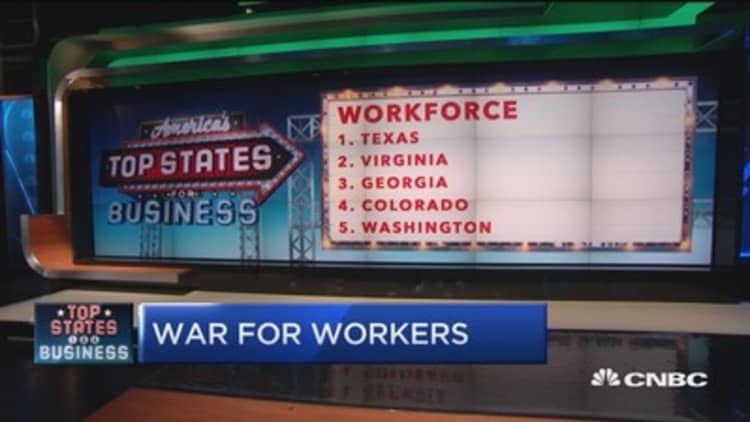
Even though the June national unemployment rate ticked up slightly to 4.4 percent, millions of people are still out of work, according to the U.S. Bureau of Labor Statistics. It reports that 1.7 million people have been out of work for six months or more. And many of those people may not be able to get a job for lack of having the right skills. It is a quandary facing the nation, and many argue it is hurting U.S. competitiveness.
Business leaders agree with a central finding of our America's Top States for Business studies over the past three years: The most crucial issue influencing corporate decisions about where to locate or expand operations is the ability to recruit and retain the best workforce.
CNBC reached out to YPO, an international organization of some 24,000 young chief executives, and our own CNBC Global CFO Council, an elite group of chief financial officers from more than 100 public and private companies. Both tell CNBC that the skills gap is reaching critical proportions.
Of the 40 members of the two organizations that responded to the informal CNBC survey conducted in June, 63 percent reported having had difficulty filling skilled positions in the past 12 months.
More than 69 percent cited the low unemployment rate, which by definition puts workers in short supply, as one of the reasons skilled employees are so hard to find. Nearly half — 46 percent — said the workforce is not receiving the proper training in the skills their companies require.
The situation is even worse for small firms. The National Federation of Independent Business, which represents some 325,000 small companies, said in its monthly Index of Small Business Optimism report in May that 86 percent of respondents had difficulty finding qualified workers when they tried to hire.

The situation is especially dire in the fast-growing software industry, which adds more than $1 trillion to the U.S. economy, according to BSA/The Software Alliance, an industry trade group representing the nation's largest software companies. The organization predicts that by 2020, there will be 1.4 million computer science–related jobs available in the U.S. but only 400,000 graduates with the skills necessary to fill them.
No easy solutions
It is no wonder that since 2015, our Top States for Business studies have consistently found "workforce" to be the most frequently cited selling point in state economic development marketing pitches to business. But it will take more than sales pitches to solve the problem.
The National Skills Coalition, which bills itself as a broad coalition of employers, unions, schools and government officials, has been working to better match state job-training programs with the skills companies need.
The group says some states are doing better than others at simply assembling data to help policymakers understand the needs of business.
Among the examples:
- The Utah Data Alliance is a partnership of six state agencies to create a database of education and workforce data. Because so many agencies are involved, policymakers get a comprehensive picture of the skills that employers need and what the state is doing to provide them.
- The South Dakota Post-Secondary Graduate Outcomes System includes information about where graduates in the state end up working, what they earn, and what industries they work in, so that educators know what skills to teach.
- Mississippi's LifeTracks system includes data on programs ranging from early childhood education through adult workforce development programs, all on a single website to help policymakers make informed decisions.
Washington weighs in
Nationally, the existence of the skills gap — and the urgent need to close it — has been one of the few areas of bipartisan agreement in Washington. But like just about everything else, there is disagreement about the solutions — and how to pay for them.
President Trump has proposed a national effort to create 4.5 million apprenticeships — combining school and on-the-job training — over the next five years. That would be 10 times the number of apprenticeships under existing federal programs. But he has yet to specify how to pay for the expanded program.
Meanwhile, the Workforce Innovation and Opportunity Act (WIOA), which overhauled U.S. job-training programs, including some dating back to the Great Depression, was signed into law by President Obama in 2014 after only three senators voted against it. The law authorizes grants to states that can demonstrate that they have aligned their job training programs with the needs of employers. The law also authorizes grants targeted at vulnerable populations, including Native Americans and youths.
But the Trump administration is proposing to slash $1.3 billion in funding for WIOA programs in next year's budget, a 36 percent decrease. The administration says it wants to shift more of the responsibility for the programs to states, localities and employers.






